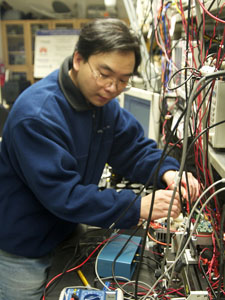Calit2 Research Engineer Wins Best Student Paper at Radio Wireless Week
February 1, 2011 / By Tiffany Fox, (858) 246-0353, tfox@ucsd.edu
San Diego, Calif., Feb. 1, 2011 — Chin Hsia, a research engineer in electrical and computer engineering at the University of California, San Diego, took home the “Best Student Paper” award from the Institute of Electrical and Electronics Engineers (IEEE) Topical Conference on Power Amplifiers for Wireless and Radio Applications at Radio Wireless Week, which took place Jan. 16-19 in Phoenix, Arizona.
|
Hsia’s paper, “Effect of Maximum Power Supply Voltage on Envelope Tracking Power Amplifiers Using GaN HEMTs,” describes a method for utilizing gallium nitride (GaN) high-electron mobility transistors (HEMTs) to reduce the amount of power consumption wireless base stations require to amplify signals.
“One of the main challenges with wireless technology development is that currently there is a bottleneck as to how to build broadband transmitters or power amplifiers with high efficiency using a cost-effective solution,” Hsia explained. “The difference between this work and previous work that has been done in this area is that we built a high dynamic range envelope modulator specifically for gallium nitride power devices. By leveraging the desirable characteristics of GaN, the high efficiency wide bandwidth base station power amplifier can be easily realized.”
GaN is a very robust, mechanically stable wide bandgap semiconductor material with high thermal conductivity. GaN HEMTS are used in various wireless infrastructure applications due to their high electron mobility, high power density, and high voltage operation.
“Basically, we demonstrated that the problem of achieving linearity and efficiency simultaneously can be solved with the use of the envelope tracking technology in conjunction with digital signal processing,” continued Hsia. “High linearity can ensure that the transmitter doesn’t interfere with other communication channels. However many previous works have shown that to achieve high linearity, one must pay the cost of low efficiency. Hence, linearity and efficiency are often conflicting constraints in our world of power amplifiers.
“However, we found that using our techniques with GaN device enhances the overall performance of the power amplifier and we can achieve both linearity and efficiency at the same time.”
Hsia conducted his research under the guidance of UCSD ECE Professors Peter Asbeck and Don Kimball at the Radio High Power Amplifier Laboratory at the UCSD division of the California Institute for Telecommunications and Information Technology (Calit2). Their work is supported, in part, by Nokia Siemens, FreeScale semiconductor, Eudyna (Sumitomo Electric Device Innovations) and ST Microelectronics. .
“Calit2 provides a very productive research environment to help us develop innovative technologies.” Hsia noted. “This technology, in particular, has been developed at Calit2 for more than 10 years and is very close to the commercial stage. I greatly appreciate the support I’ve received at Calit2.”
Originally from Taiwan, Hsia received his M. S. engineering degree from National Taiwan University and his Ph.D. degree in ECE from UCSD. His long-term research goal is to commercialize the envelope-tracking technology he has developed at Calit2 and become a professional in the wireless technology industry.
Related Links
Media Contacts
Tiffany Fox, (858) 246-0353, tfox@ucsd.edu


